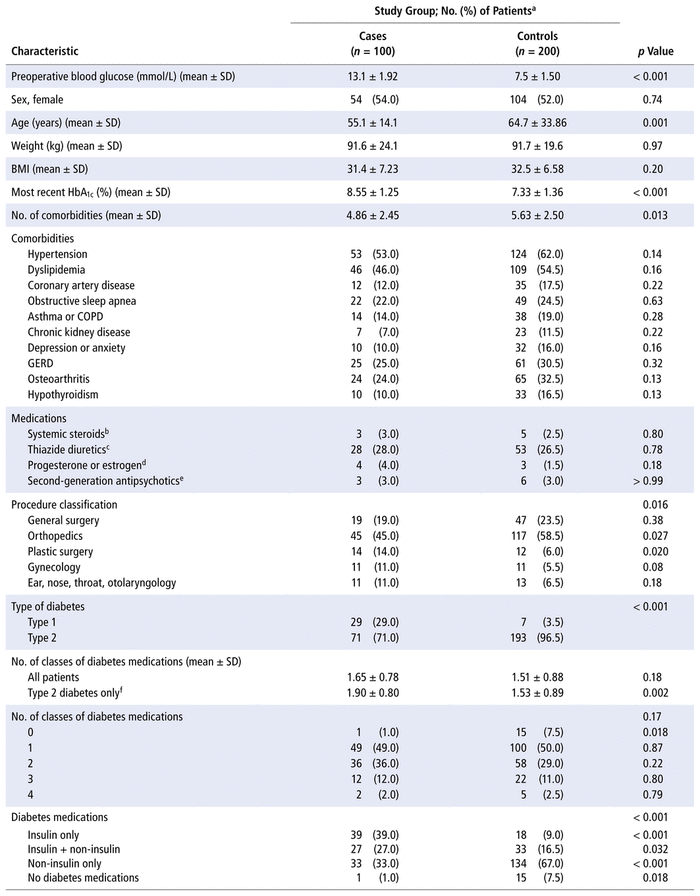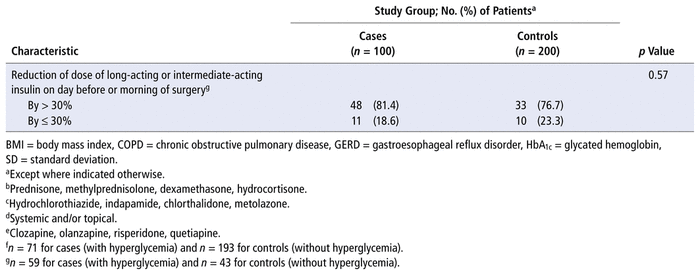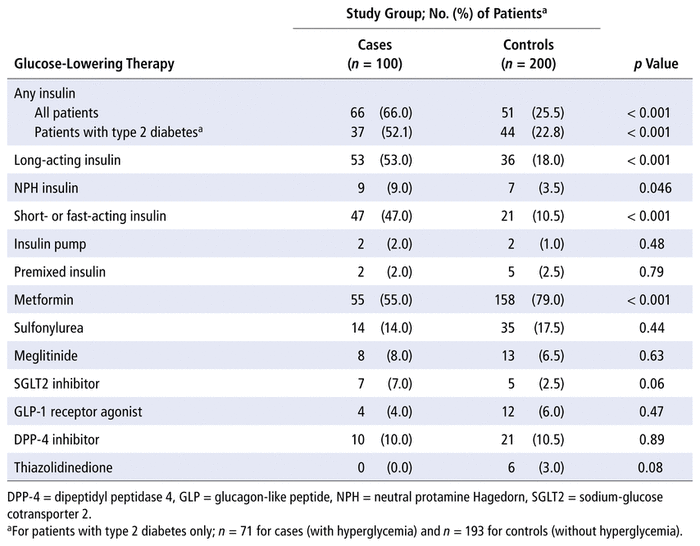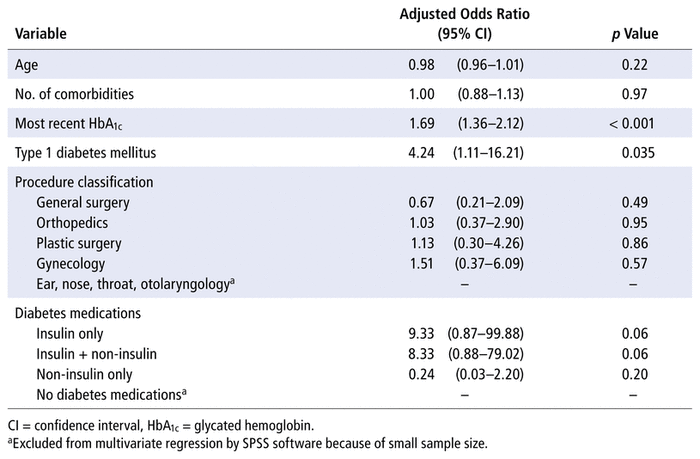

Peter Van Herk , Nathaniel Morin , Deonne Dersch-Mills , Rhonda Roedler , Beverly Ang , Lori OlivieriABSTRACT
Background
Patients with diabetes are more likely to undergo a surgical procedure than the rest of the population, and it is well established that preoperative hyperglycemia is associated with adverse surgical outcomes. However, it is currently unknown what factors increase the odds of preoperative hyperglycemia in people with diabetes.
Objective
To identify patient characteristics that increase the risk of preoperative hyperglycemia.
Methods
This retrospective case–control study compared 100 patients with preoperative hyperglycemia on admission for elective surgery at South Health Campus in Calgary, Alberta (blood glucose > 10.9 mmol/L) with 200 controls who did not have preoperative hyperglycemia on admission for elective surgery (blood glucose ≤ 10.9 mmol/L). Multivariate logistic regression was used to identify risk factors for preoperative hyperglycemia.
Results
In the univariate analysis, age, number of comorbidities, increasing glycated hemoglobin (HbA 1c ), type of diabetes, type of procedure, and diabetes medications (non-insulin, insulin, both, or none) were associated with increased odds of preoperative hyperglycemia ( p < 0.05). However, in the adjusted analysis, only increasing HbA 1c (odds ratio [OR] 1.69, 95% confidence interval [CI] 1.36–2.12) and type 1 diabetes (OR 4.24, 95% CI 1.11–16.21, relative to type 2 diabetes) were associated with preoperative hyperglycemia.
Conclusions
These results can help clinicians to identify patients who may be at increased risk of hyperglycemia before an elective procedure. They also allow for treatment of those who would benefit most from additional guidance with regard to preoperative glucose management.
KEYWORDS: risk factors , preoperative hyperglycemia , diabetes mellitus , case , control study
RÉSUMÉ
Contexte
Les patients diabétiques sont plus susceptibles que le reste de la population de subir une intervention chirurgicale, et il est bien connu que l’hyperglycémie préopératoire est associée à des résultats chirurgicaux indésirables. Cependant, on ignore actuellement quels facteurs augmentent ce risque chez les personnes atteintes de diabète.
Objectif
Déterminer les caractéristiques des patients qui augmentent le risque d’hyperglycémie préopératoire.
Méthodes
Cette étude cas-témoins rétrospective a comparé 100 patients présentant une hyperglycémie préopératoire à l’admission pour une intervention chirurgicale non urgente au South Health Campus de Calgary, en Alberta (glycémie > 10,9 mmol/L) avec 200 témoins qui n’en présentaient pas (glycémie ≤ 10,9 mmol/L). La détermination des facteurs de risque d’hyperglycémie préopératoire s’est faite par régression logistique multivariée.
Résultats
Dans l’analyse univariée, l’âge, le nombre de comorbidités, l’augmentation du taux d’hémoglobine glyquée (HbA 1c ), le type de diabète, le type d’intervention et les médicaments contre le diabète (non-insuline, insuline, les deux ou aucun) étaient associés à un risque accru d’hyperglycémie préopératoire ( p < 0,05). Cependant, dans l’analyse ajustée, seuls l’augmentation de l’HbA 1c (rapport de cotes [RC] 1,69; intervalle de confiance [IC] à 95 % 1,36–2,12) et le diabète de type 1 (RC 4,24; IC à 95 % 1,11–16,21, par rapport au diabète de type 2) étaient associés à une hyperglycémie préopératoire.
Conclusions
Ces résultats peuvent aider les cliniciens à repérer les patients qui pourraient présenter un plus grand risque d’hyperglycémie avant une intervention non urgente. Ils permettent également de traiter ceux qui bénéficieraient le plus de conseils supplémentaires en matière de gestion préopératoire de la glycémie.
MOTS CLÉS: facteurs de risque , hyperglycémie préopératoire , diabète sucré , étude cas-témoins
Approximately 10% of Canadians have diabetes, and the incidence of diabetes is expected to grow exponentially, surpassing 12% by 2025.1 Furthermore, about 20% of Canadians had prediabetes in 2015, meaning that almost one-third of Canada’s population is at risk for development of diabetes or already has the disorder.1 Because people who have diabetes are more likely to undergo surgery than those who do not, a large proportion of surgical patients have diabetes or prediabetes.2 The World Health Organization has identified 4 key components for reliable perioperative care: antimicrobial coverage, appropriate removal of hair, perioperative normothermia, and perioperative glucose control.3 With the growing population of people who have diabetes and prediabetes, perioperative glucose control and the adverse effects of perioperative hyperglycemia are gaining attention.
It is well established that diabetes and elevated preoperative blood glucose levels are associated with adverse outcomes in noncardiac surgery.4–7 Surgical patients often have their antihyperglycemic medications held or reduced on the day of surgery to avoid hypoglycemia while fasting, which further increases their risk of preoperative hyperglycemia, especially if their surgery is scheduled for later in the day. Noordzij and others4 demonstrated that preoperative blood glucose levels greater than 11.1 mmol/L and those between 5.6 and 11.1 mmol/L were associated with 2.1-fold and 1.7-fold increased mortality risks, respectively, when compared with normoglycemia. In terms of cardiovascular mortality specifically, these risks increased to 4-fold and 3-fold, respectively.4 Furthermore, Frisch and others5 found that patients who died within 30 days after their surgery had significantly higher blood glucose levels before and after the procedure.5 Perioperative hyperglycemia is also associated with a higher risk for acute myocardial infarction, acute renal failure, urinary tract infection, systemic infection, and postoperative pneumonia, as well as increased lengths of stay both within the hospital and in the intensive care unit (ICU). Finally, for every 1 mmol/L increase in blood glucose before surgery, the risk of death increases by 19%.4,8
These findings reinforce the advantage of proactively identifying and planning for possible hyperglycemia in those people at risk, rather than relying upon surgical staff to take an appropriate reactive approach should hyperglycemia occur. Currently, pharmacists providing services in the Pre-Admission Clinic (PAC) of the South Health Campus, Calgary, Alberta, see patients scheduled for elective surgery a few weeks before their procedure and attempt to identify patients with diabetes who may be at increased risk of preoperative hyperglycemia. The PAC pharmacists assess the risk of hyperglycemia using patient history, background knowledge of diabetes, and standard practices regarding management of hypoglycemic medication in preparation for surgery. In turn, the pharmacists prescribe insulin correction scales to be applied for patients whose blood glucose exceeds 10.9 mmol/L when they are admitted before surgery, using calculated insulin sensitivity that targets blood glucose of 9 mmol/L.
To date, very little research has been done to identify risk factors for preoperative hyperglycemia. It has previously been shown that diabetes and duration of surgery are risk factors for intraoperative dysglycemia in elderly patients undergoing elective surgery.9 Furthermore, in a prospective observational study that included patients with and without diabetes undergoing primary hip or knee replacement, Jämsen and others10 found that a prior diagnosis of diabetes, higher glycated hemoglobin (HbA 1c ) and higher fasting glucose on the operative day were associated with postoperative hyperglycemia. Finally, in a retrospective cohort study of children with traumatic brain injuries who underwent craniotomy, age less than 4 years, severe brain injury, and the presence of multiple lesions were risk factors for preoperative, intraoperative, or postoperative hyperglycemia.11 However, to our knowledge, no study to date has investigated the risk factors for preoperative hyperglycemia in patients with diabetes who are undergoing elective noncardiac surgery. This study therefore fills an important knowledge gap that will ultimately empower clinicians to provide better surgical care, as they will be better able to plan for their diabetic patients’ perioperative glycemic control when seeing them in a PAC or similar setting.
This case–control study included patients with type 1 or type 2 diabetes who underwent elective surgery at South Health Campus between 2014 and 2019. The cases were defined as patients with preoperative blood glucose above 10.9 mmol/L, and the controls were those with preoperative blood glucose of 10.9 mmol/L or below. Patients were matched, in a 2 to 1 ratio of controls to cases, based on the year of the procedure, to reduce the risk that practice changes related to treatment of hyperglycemia and treatment of diabetes in general would influence any of the findings. Patient identification started with surgical admissions on January 1, 2014, and continued chronologically until each group was populated. The data collectors were not blinded; however, a standardized data collection approach was used, and all data collected were objective, which limited the amount of bias that could be introduced.
Alberta Health Services Analytics (Data Integration, Measurement and Reporting) provided a list of all patients with preoperative blood glucose levels recorded on their surgical chart before surgery at South Health Campus. At this location, only people with a known diagnosis of diabetes undergo preoperative blood glucose testing, which is performed by nursing staff certified to use a point-of-care Accuchek Inform II blood glucose machine (Roche), calibrated once each day. From this list, 100 patients with preoperative blood glucose above 10.9 mmol/L (hyperglycemia) and 200 patients with preoperative blood glucose less than or equal to 10.9 mmol/L (euglycemia) were selected for comparison. Patients’ baseline demographic data and characteristics were gathered from electronic charts (Sunrise Clinical Manager).
To be included in the study, patients had to have undergone elective noncardiac surgery between January 1, 2014, and December 31, 2019; had to have a preoperative blood glucose value entered in the surgical chart; and had to have a documented diagnosis of diabetes, with a record of antihyperglycemic medications, insulin, or the indication of diabetes during their PAC consult. Patients were excluded from the study if they were not seen in the PAC by either an internal medicine or anesthesia provider before the surgery, did not have surgery after their PAC appointment, were missing data for the predetermined characteristics to be compared between the groups, or underwent bariatric surgery (because the current standard for this type of surgery is an all-liquid diet, which drastically changes insulin sensitivity).
Several patient characteristics were compared between the cases and controls in a univariate analysis, specifically sex, age, body mass index, number of comorbidities (as recorded in the PAC consult note), most recent HbA 1c (i.e., at the time of the PAC visit), current diabetes medications, use of medications known to cause hyperglycemia, type of procedure, type of diabetes, and preoperative reduction of insulin dose. Categorical variables (sex, medications, type of procedure, type of diabetes, and insulin dose reduction) were analyzed using χ2 tests, and continuous variables (age, body mass index, number of comorbidities, HbA 1c ) were analyzed using the t test. As a secondary analysis, a multivariate logistic regression analysis that included all variables with statistical significance ( p < 0.05) in the univariate analysis was performed to determine which patient characteristics remained associated with preoperative hyperglycemia after adjustment. Multicollinearity between variables was assessed, and variables with a variance inflation factor greater than 3 were excluded from the multivariate analysis. The model’s goodness of fit was determined by calculating the Nagelkerke R 2 value.12 The C-statistic was calculated to determine the model’s predictive accuracy.13 SPSS Statistics software (version 25, IBM Corporation) was used to analyze the data.
Ethics approval was granted by the University of Calgary Conjoint Health Research Ethics Board. Given the retrospective nature of the study, it was not feasible to obtain patient consent; therefore, the ethics board also granted a waiver of consent. Appropriate safeguards were put in place to protect the privacy of the patients included in the study.
Altogether, this study included 100 patients with preoperative hyperglycemia and 200 matched controls who did not have preoperative hyperglycemia. To populate these 100 cases and 200 controls, 210 hyperglycemic patients and 418 euglycemic patients were screened, respectively. A baseline description of the cohorts is shown in Table 1. The average preoperative blood glucose level was 13.1 (standard deviation [SD] 1.92) mmol/L among cases and 7.5 (SD 1.50) mmol/L among controls. The case group was younger, had fewer comorbidities, had higher average HbA 1c (8.55% [SD 1.25%] versus 7.33% [SD 1.36%]), had a higher proportion of patients with type 1 diabetes (29% versus 3.5%), had higher proportions of patients taking insulin alone or in combination with non-insulin medications, and had lower proportions of patients taking only non-insulin or no hypoglycemic medications. Differences in the types of surgical procedures were also observed, with a lower proportion of cases undergoing elective orthopedic surgery, whereas a lower proportion of controls underwent plastic surgery procedures.
TABLE 1
Comparison of Variables among Study Groups Using Univariate Analysis


A more detailed breakdown of the proportions of cases and controls who were taking specific classes of diabetes medications is presented in Table 2. Because of collinearity with other characteristics, diabetes medication class was not included in the multivariate regression; instead, a more general breakdown of the types of medications (insulin only, non-insulin only, insulin and non-insulin [concurrent], neither) was included in the multivariate regression analysis.
TABLE 2
Specific Classes of Diabetes Medications Used by Patients

The multivariate logistic regression analysis was performed with all characteristics from Table 1 that were significantly different between cases and controls (Table 3). The Nagelkerke R 2 value of 0.368 indicated that 36.8% of the variance in the dependent variable was explained by the model.12 Furthermore, the model had a C-statistic of 0.757, meaning that it correctly classified 75.7% of cases.13 Patients with type 1 diabetes had 4.24 higher odds (95% confidence interval [CI] 1.11–16.21) of preoperative hyperglycemia, and for every 1% increase in HbA 1c , the odds of hyperglycemia increased by 1.69-fold (95% CI 1.36–2.12).
TABLE 3
Multivariate Logistic Regression Model for Preoperative Hyperglycemia Risk Factors

In this study of people with diabetes, comparison of patients with and without preoperative hyperglycemia showed that increasing HbA 1c and a diagnosis of type 1 diabetes were significantly predictive of preoperative hyperglycemia. HbA 1c provides a “snapshot” of glycemic control over the previous 3 months, so it is not surprising that patients with higher HbA 1c were at increased risk of preoperative hyperglycemia, given research showing that elevation of HbA 1c is positively correlated with elevation of fasting blood sugars.12,14 Patients with type 1 diabetes have an insulin production disorder, whereas those with type 2 diabetes have at least some endogenous insulin production. Even though the insulin produced in type 2 diabetes is insufficient to meet all metabolic requirements, it may still be enough to cover basic metabolic processes and keep blood sugars in the recommended range of 5 to 10 mmol/L during the fasting preoperative period. Illustrating this theory is research published by Monnier and others14 and Riddle and others,15 who showed that among people with diabetes and relatively lower HbA 1c (6% to 8%), the postprandial period is when hyperglycemia occurs, whereas in those with higher HbA 1c (above 9%), fasting blood sugars are also above the range accepted as normal. Given that people with type 1 diabetes produce no insulin at all, the common recommendation of reducing basal insulin dosage to prevent hypoglycemia while fasting preoperatively may place these people into an insulin deficit sufficient to raise their fasting blood sugars above the normal threshold, which would account for our findings.
Interestingly, patients in our study who presented with preoperative hyperglycemia had a lower total number of reported comorbidities than controls (4.86 versus 5.63, p = 0.013), in addition to a lower, though nonsignificant, incidence of each of the 10 most prevalent comorbid conditions (see Table 1). We attribute these findings to multiple possibilities. One potential explanation is that people with more comorbidities may be deemed “higher risk” for surgery and thus may not be cleared for an elective procedure until better glycemic control has been achieved. For example, someone with previous myocardial infarction or stroke and suboptimal blood sugar control may not be allowed to proceed until their blood sugars are better controlled, whereas poorer glycemic control may be tolerated among those deemed to be “lower risk” with only a few comorbidities. Another possible explanation is that people in the hyperglycemic (case) group were more likely than those in the control group to have type 1 diabetes (29% versus 3.5% prevalence, respectively), a condition that is more prevalent in the younger population who have not lived long enough for other comorbidities to develop. This possible explanation is affirmed by the finding that average age was significantly lower among cases than among controls (55.1 versus 64.7 years).
Patients undergoing a plastic surgery procedure were more likely to have preoperative hyperglycemia, whereas patients undergoing an orthopedic procedure were more likely to have preoperative euglycemia. A possible explanation for the observation relating to plastic surgery procedures is that the risk associated with hyperglycemia might have been accepted by the patient and surgeon because of the perceived urgency of surgery, as these procedures included skin grafts, debridements, and nerve decompressions. The orthopedic procedures (knee, hip, and shoulder arthroscopy) were likely deemed less urgent, making the risk of hyperglycemia less acceptable. People having less urgent elective surgery were likely required to achieve better glycemic control before their procedure was scheduled.
This study had several limitations. Socioeconomic status is an important determinant of health and could not be assessed from the data available. We were unable to assess adherence to prescribed medications and/or preoperative instructions, such as holding of medications before the procedure or adjustment of insulin doses. Data collected were from patients who underwent elective surgical procedures before the widespread use and improved accessibility of the sodium-glucose cotransporter 2 (SGLT2) inhibitors or glucagon-like peptide 1 (GLP-1) analogues in Alberta, so we were unable to assess the impact of these agents on preoperative hyperglycemia. Because the site only started its surgical program in 2014, we also had a limited number of patients with preoperative hyperglycemia from whom to draw our cases, which limited the statistical power of the study. Finally, some patients may have corrected their hyperglycemia themselves with short-acting insulin before presenting to hospital for their elective procedure. These patients would have presented with euglycemia, whereas they would otherwise have had hyperglycemia.
Our results align with and expand on those of Jämsen and others,10 who aimed to identify the risk factors for perioperative hyperglycemia following hip and knee replacement. In their prospective observational study of 191 people with osteoarthritis, diabetes was shown to be a significant risk factor for hyperglycemia. Even though the study included only 36 people with diabetes, there was a trend toward insulin therapy being an independent risk factor for hyperglycemia. All 9 of those who were taking insulin preoperatively presented with hyperglycemia, compared with only 19 of the 27 people treated with oral diabetes medications ( p = 0.06), similar to the result in our study. Furthermore, a strong association between HbA 1c and hyperglycemia was demonstrated, as the risk of hyperglycemia was approximately 4-fold higher among people with HbA 1c greater than or equal to 6.5%. Similar to our findings, Jämsen and others10 showed that none of the self-reported comorbidities were associated with an increased risk of hyperglycemia.
Increasing HbA 1c and type 1 diabetes were associated with increased odds of preoperative hyperglycemia among people with diabetes undergoing elective surgery after assessment in a preoperative assessment clinic. Further studies with larger groups of patients should be done to identify additional risk factors for preoperative hyperglycemia, especially with the increased use of SGLT2 inhibitors and GLP-1 agonists. It has previously been well established that preoperative hyperglycemia increases the risk of poor postsurgical outcomes, including infection, cardiac complications, renal failure, pneumonia, systemic infections, longer stays in the ICU or the hospital, and death.4–7 People with preoperative hyperglycemia can logically be assumed to have the highest risk for intraoperative and postoperative hyperglycemia, which are known risk factors for postoperative morbidity and mortality. The information we have presented has real-world applicability and can be used by clinicians in identifying people at increased risk of preoperative hyperglycemia; it also allows for a proactive and informed approach that involves planning for improved surgical glycemic control.
1 Diabetes Canada Clinical Practice Guidelines Expert Committee; Houlden RL. Introduction. Can J Diabetes. 2018;42 Suppl 1:S1–S5.
Crossref PubMed
2 Smiley DD, Umpierrez GE. Perioperative glucose control in the diabetic or nondiabetic patient. South Med J. 2006;99(6):580–9.
Crossref PubMed
3 Global guidelines for the prevention of surgical site infection. 2nd ed. World Health Organization; 2018 [cited 2021 Nov 2]. Available from: https://apps.who.int/iris/handle/10665/277399
4 Noordzij P, Boersma E, Schreiner F, Kertal M, Feringa H, Dunkelgun M, et al. Increased pre-operative glucose levels are associated with perioperative mortality in patients undergoing noncardiac, nonvascular surgery. Eur J Endocrinol. 2007;156(1):137–42.
Crossref PubMed
5 Frisch A, Chandra P, Smiley D, Peng L, Rizzo M, Gatcliffe C, et al. Prevalence and clinical outcome of hyperglycemia in the perioperative period in non-cardiac surgery. Diabetes Care. 2010;33(8):1783–8.
Crossref PubMed PMC
6 Abdelmalak BB, Knittel J, Abdelmalak JB, Dalton JE, Christiansen E, Foss J, et al. Pre-operative blood glucose concentrations and postoperative outcomes after elective non-cardiac surgery: an observational study. Br J Anaesth. 2014;112(1):79–88.
Crossref
7 Umpierrez GE, Isaacs SD, Bazargan N, You X, Thaler LM, Kitabchi AE. Hyperglycemia: an independent marker of in-hospital mortality in patients with undiagnosed diabetes. J Clin Endocrinol Metab. 2002;87(3):978–82.
Crossref PubMed
8 Kotagal M, Symons RG, Hirsch IB, Umpierrez GE, Dellinger EP, Farrokhi ET, et al.; SCOAP-CERTAIN Collaborative. Perioperative hyperglycemia and risk of adverse events among patients with and without diabetes. Ann Surg. 2015;261(1):97–103.
Crossref
9 Knaak C, Wollersheim T, Mörgeli R, Spies C, Vorderwülbecke G, Windmann V, et al. Risk factors of intraoperative dysglycemia in elderly surgical patients. Int J Med Sci. 2019;16(5):665–74.
Crossref PubMed PMC
10 Jämsen E, Nevalainen PI, Eskelinen A, Kalliovalkama J, Moilanen T. Risk factors for perioperative hyperglycemia in primary hip and knee replacements. Acta Orthop. 2015;86(2):175–82.
Crossref PMC
11 Sharma D, Jelacic J, Chennuri R, Chaiwat O, Chandler W, Vavilala MS. Incidence and risk factors for perioperative hyperglycemia in children with traumatic brain injury. Anesth Analg. 2009;108(1):81–9.
Crossref PMC
12 Nagelkerke NJD. A note on general definition of the coefficient of determination. Biometrika. 1991;78(3):691–2.
Crossref
13 Caetano SJ, Sonpavde G, Pond GR. C-statistic: a brief explanation of its construction, interpretation and limitations. Eur J Cancer. 2018; 90:130–2.
Crossref
14 Monnier L, Lapinski H, Colette C. Contributions of fasting and postprandial plasma glucose increments to the overall diurnal hyperglycemia of type two diabetic patients: variations with increasing levels of HbA(1c). Diabetes Care. 2003;26(3):881–5.
Crossref PubMed
15 Riddle M, Umpierrez G, DiGenio A, Zhou R, Rosenstock J. Contributions of basal and postprandial hyperglycemia over a wide range of A1C levels before and after treatment intensification in type 2 diabetes. Diabetes Care. 2011;34(12):2508–14.
Crossref PubMed PMC
Competing interests: None declared. ( Return to Text )
Funding: None received. ( Return to Text )
Canadian Journal of Hospital Pharmacy , VOLUME 75 , NUMBER 1 , Winter 2022